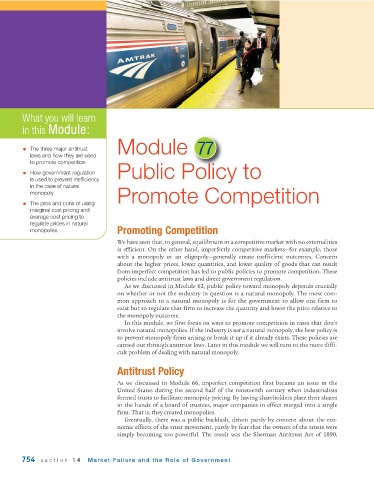Page 796 - Krugmans Economics for AP Text Book_Neat
P. 796
What you will learn
in this Module:
• The three major antitrust Module 77
laws and how they are used
to promote competition
• How government regulation Public Policy to
is used to prevent inefficiency
in the case of natural
monopoly Promote Competition
• The pros and cons of using
marginal cost pricing and
average cost pricing to
regulate prices in natural
monopolies Promoting Competition
We have seen that, in general, equilibrium in a competitive market with no externalities
is efficient. On the other hand, imperfectly competitive markets—for example, those
with a monopoly or an oligopoly—generally create inefficient outcomes. Concern
about the higher prices, lower quantities, and lower quality of goods that can result
from imperfect competition has led to public policies to promote competition. These
policies include antitrust laws and direct government regulation.
As we discussed in Module 62, public policy toward monopoly depends crucially
on whether or not the industry in question is a natural monopoly. The most com-
mon approach to a natural monopoly is for the government to allow one firm to
exist but to regulate that firm to increase the quantity and lower the price relative to
the monopoly outcome.
In this module, we first focus on ways to promote competition in cases that don’t
involve natural monopolies. If the industry is not a natural monopoly, the best policy is
to prevent monopoly from arising or break it up if it already exists. These policies are
carried out through antitrust laws. Later in this module we will turn to the more diffi-
cult problem of dealing with natural monopoly.
Antitrust Policy
As we discussed in Module 66, imperfect competition first became an issue in the
United States during the second half of the nineteenth century when industrialists
formed trusts to facilitate monopoly pricing. By having shareholders place their shares
in the hands of a board of trustees, major companies in effect merged into a single
firm. That is, they created monopolies.
Eventually, there was a public backlash, driven partly by concern about the eco-
nomic effects of the trust movement, partly by fear that the owners of the trusts were
simply becoming too powerful. The result was the Sherman Antitrust Act of 1890,
754 section 14 Market Failure and the Role of Gover nment

